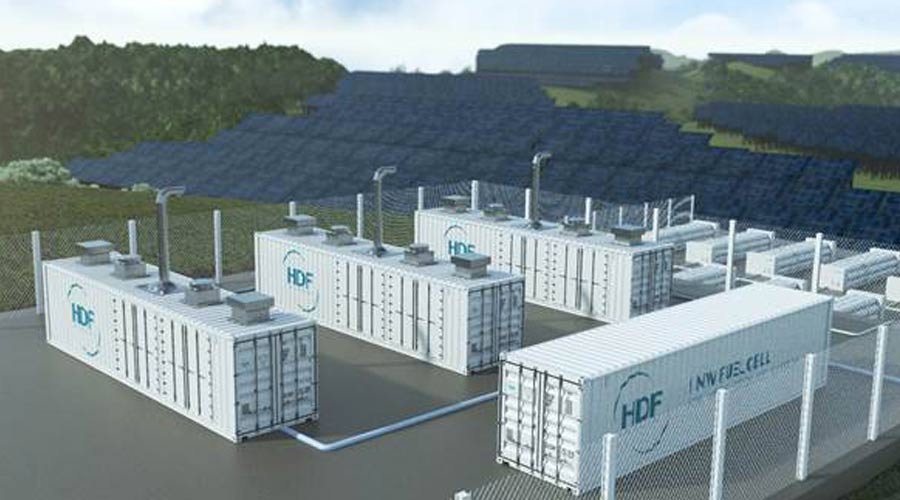
Charlie Desmoulins
Charlie Desmoulins, Director of Operations, at HDF talks about the challenges of these projects in relation to ecological and environmental aspects and cooperation with Apave.
What are HDF’s values?
The company’s values or missions offer, in particular, a third way of generating electricity, alongside conventional thermal and renewable energy plants: a power plant producing non-intermittent electricity, guaranteed 24/7 all year round, like a thermal power plant but pollution-free. Renewable energy is now the cheapest source of electricity but its intermittent nature limits its development. We have succeeded in removing the barrier of this physical limit by integrating mass hydrogen-based storage into a renewable energy plant to deliver a basic electrical current, like as a thermal plant, while remaining competitive and respecting the objectives of the Paris Agreement, which are essential for the planet.
On which projects and for what reasons did you want to be supported by expert environmental consultants?
HDF Energy’s projects are part of a virtuous approach to decarbonising electricity production. Furthermore, our commitment as a company is to try to put in place infrastructure that is as ecologically and environmentally-friendly as possible.
Major work, lasting several months is needed to build a facility, which necessarily has short and long-term impacts on the nearby environment. It is essential to anticipate these impacts and work on avoiding and reducing them with the right specialist partners in this field. We were supported by Apave for the West Guyana Electric Power Plant (CEOG) project.


The specificities of the West Guyana Electric Power Plant (CEOG)
CEOG produces stable electricity, day and night, for the equivalent of 10,000 households, from intermittent renewable energy (photovoltaic) thanks to mass storage in the form of hydrogen. Unlike a conventional photovoltaic power station, CEOG functions like a thermal power station in that it produces basic electricity 24 hours a day whose power is fixed, and technically and contractually guaranteed to the electricity grid operator.
CEOG is in fact the world's first multi-megawatt hydrogen plant. Its electricity production is non-polluting, requires no fuel logistics, does not depend on any other channel being set up, and is competitive compared to the cost of thermal production in French Guiana, at a known and decreasing price during its 25 years of operation.
Finally, after reviewing its planning application , CEOG was hailed by the DGTM as an exemplary project in terms of environmental impact.
Why did you choose Apave?
In addition to its very solid environmental knowledge, Apave has very advanced know-how in at-risk installations and associated hazard studies. Renewstable® includes a hydrogen chain and batteries. This equipment requires that the right operability methods and the right means of protection are used to avoid any risk of an incident occurring. This know-how was therefore essential for us and Apave combines technical expertise with environmental expertise.
Apave demonstrated to us from the outset its attachment to our innovative projects and its support for our approach.
Finally, geographical proximity with the Bordeaux agency was an important criterion for optimally integrating the teams and developing a relationship of trust.
What were the main phases of the collaboration with Apave for this project?
Apave supported us with preparing the single environmental permit application (DAEU) for the CEOG project. This mission began in early 2019 and ended in late 2020. In late 2019, we obtained an initial prefectural authorisation, recently modified after submission of a notification of changes made to the project (two files submitted and validated during this period). Apave therefore supported us and was able to respond to all the constraints connected to the project and to the requests from the authorities.
The first phase focused on a good understanding of the project and how technologically and administratively it is innovative. Then, the designs and inventories were launched and conducted on the basis of a common understanding, which allowed us to submit the complete and substantiated application in good time.
Finally, exchanges with the authorities went very smoothly: our project and our application were recognised as exemplary by the authorities, which meant they were approved in very short time frames. This joint success was repeated with the amendments made to our DAEU following changes to the design of the plant and enabled us to launch construction of CEOG in late 2020.
What advantages have you noted by working with Apave?
The main and most critical advantage for us is of course obtaining the CEOG Operating Permit. Recognition of the exemplary nature of our application by the DGTM (Direction Générale des Territoires et de la Mer de Guyane) fulfils a strong commitment by HDF in its policy of developing sustainable and environmentally-friendly infrastructure.
Based on this experience and collaboration, we are better equipped to continue developing our projects, to promote the exemplary features that we wish to give to our approach in all the countries in which we are present.
In a few words, how would you sum up your collaboration with Apave?
3 points emerge from our collaboration with Apave:
- Simplicity in performing the work and collaboration
- Determination in the contacts and demonstrations with the authorities
- Professionalism and rigour in all aspects of the project
Finally, as CEOG is a world first, it was enjoyable to work with an APAVE team that was particularly motivated by this pioneering project. Together, we were aware of contributing to shifting the paradigm in terms of energy production!
On the same
topic
